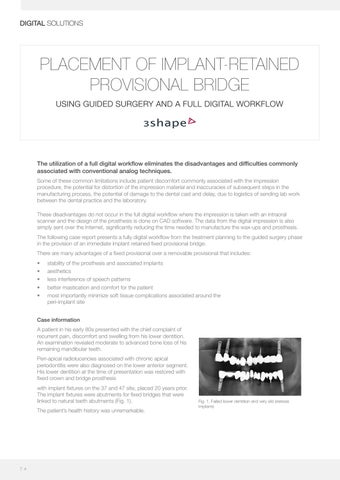DIGITAL SOLUTIONS
PLACEMENT OF IMPLANT-RETAINED PROVISIONAL BRIDGE USING GUIDED SURGERY AND A FULL DIGITAL WORKFLOW
The utilization of a full digital workflow eliminates the disadvantages and difficulties commonly associated with conventional analog techniques. Some of these common limitations include patient discomfort commonly associated with the impression procedure, the potential for distortion of the impression material and inaccuracies of subsequent steps in the manufacturing process, the potential of damage to the dental cast and delay, due to logistics of sending lab work between the dental practice and the laboratory. These disadvantages do not occur in the full digital workflow where the impression is taken with an intraoral scanner and the design of the prosthesis is done on CAD software. The data from the digital impression is also simply sent over the Internet, significantly reducing the time needed to manufacture the wax-ups and prosthesis. The following case report presents a fully digital workflow from the treatment planning to the guided surgery phase in the provision of an immediate implant retained fixed provisional bridge. There are many advantages of a fixed provisional over a removable provisional that includes: • • • • •
stability of the prosthesis and associated implants aesthetics less interference of speech patterns better mastication and comfort for the patient most importantly minimize soft tissue complications associated around the peri-implant site
Case information A patient in his early 80s presented with the chief complaint of recurrent pain, discomfort and swelling from his lower dentition. An examination revealed moderate to advanced bone loss of his remaining mandibular teeth. Peri-apical radiolucencies associated with chronic apical periodontitis were also diagnosed on the lower anterior segment. His lower dentition at the time of presentation was restored with fixed crown and bridge prosthesis with implant fixtures on the 37 and 47 site, placed 20 years prior. The implant fixtures were abutments for fixed bridges that were linked to natural teeth abutments (Fig. 1). The patient’s health history was unremarkable.
7 4
Fig. 1. Failed lower dentition and very old sterioss implants











